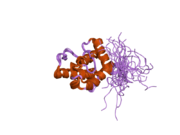Biology:LCP1
 Generic protein structure example |
Plastin-2 is a protein that in humans is encoded by the LCP1 gene.[1]
Function
Plastins are a family of actin-binding proteins that are conserved throughout eukaryote evolution and expressed in most tissues of higher eukaryotes. In humans, two ubiquitous plastin isoforms (L and T) have been identified. Plastin 1 (otherwise known as fimbrin) is a third distinct plastin isoform which is specifically expressed at high levels in the small intestine. The L isoform is expressed only in hemopoietic cell lineages, while the T isoform has been found in all other normal cells of solid tissues that have replicative potential (fibroblasts, endothelial cells, epithelial cells, melanocytes, etc.). However, L-plastin has been found in many types of malignant human cells of non-hemopoietic origin suggesting that its expression is induced accompanying tumorigenesis in solid tissues.[2]
References
- ↑ "Characterization of interleukin 2 stimulated 65-kilodalton phosphoprotein in human T cells". Biochemistry 29 (4): 1055–62. January 1990. doi:10.1021/bi00456a030. PMID 2111166.
- ↑ "Entrez Gene: LCP1 lymphocyte cytosolic protein 1 (L-plastin)". https://www.ncbi.nlm.nih.gov/sites/entrez?Db=gene&Cmd=ShowDetailView&TermToSearch=3936.
Further reading
- "Human T cell L-plastin bundles actin filaments in a calcium-dependent manner". Journal of Biochemistry 112 (4): 503–7. October 1992. doi:10.1093/oxfordjournals.jbchem.a123929. PMID 1491005.
- "65-kilodalton protein phosphorylated by interleukin 2 stimulation bears two putative actin-binding sites and two calcium-binding sites". Biochemistry 29 (36): 8319–24. September 1990. doi:10.1021/bi00488a017. PMID 2252891.
- "Correction of the N-terminal sequences of the human plastin isoforms by using anchored polymerase chain reaction: identification of a potential calcium-binding domain". Molecular and Cellular Biology 10 (4): 1818–21. April 1990. doi:10.1128/MCB.10.4.1818. PMID 2378651.
- "Molecular cloning and characterization of plastin, a human leukocyte protein expressed in transformed human fibroblasts". Molecular and Cellular Biology 8 (11): 4659–68. November 1988. doi:10.1128/MCB.8.11.4659. PMID 3211125.
- "Purification and characterization of a cytosolic 65-kilodalton phosphoprotein in human leukocytes whose phosphorylation is augmented by stimulation with interleukin 1". Biochemistry 27 (10): 3765–70. May 1988. doi:10.1021/bi00410a037. PMID 3261603.
- "A case report of a patient with retinoblastoma and chromosome 13q deletion: assignment of a new gene (gene for LCP1) on human chromosome 13". Human Genetics 71 (3): 263–6. 1986. doi:10.1007/BF00284588. PMID 3864729.
- "Functional differences between L- and T-plastin isoforms". The Journal of Cell Biology 127 (6 Pt 2): 1995–2008. December 1994. doi:10.1083/jcb.127.6.1995. PMID 7806577.
- "Oligo-capping: a simple method to replace the cap structure of eukaryotic mRNAs with oligoribonucleotides". Gene 138 (1–2): 171–4. January 1994. doi:10.1016/0378-1119(94)90802-8. PMID 8125298.
- "Identification of I-plastin, a human fimbrin isoform expressed in intestine and kidney". Molecular and Cellular Biology 14 (4): 2457–67. April 1994. doi:10.1128/mcb.14.4.2457. PMID 8139549.
- "Human plastin genes. Comparative gene structure, chromosome location, and differential expression in normal and neoplastic cells". The Journal of Biological Chemistry 268 (4): 2781–92. February 1993. doi:10.1016/S0021-9258(18)53842-4. PMID 8428952.
- "Characterization of the human L-plastin gene promoter in normal and neoplastic cells". The Journal of Biological Chemistry 268 (4): 2793–801. February 1993. doi:10.1016/S0021-9258(18)53843-6. PMID 8428953.
- "FcgammaRII-mediated adhesion and phagocytosis induce L-plastin phosphorylation in human neutrophils". The Journal of Biological Chemistry 271 (24): 14623–30. June 1996. doi:10.1074/jbc.271.24.14623. PMID 8663066.
- "Construction and characterization of a full length-enriched and a 5'-end-enriched cDNA library". Gene 200 (1–2): 149–56. October 1997. doi:10.1016/S0378-1119(97)00411-3. PMID 9373149.
- "The extracellular processing of HIV-1 envelope glycoprotein gp160 by human plasmin". FEBS Letters 442 (1): 39–42. January 1999. doi:10.1016/S0014-5793(98)01612-3. PMID 9923600.
- "Immune complex-induced integrin activation and L-plastin phosphorylation require protein kinase A". The Journal of Biological Chemistry 274 (34): 24349–56. August 1999. doi:10.1074/jbc.274.34.24349. PMID 10446213.
- "Upregulation of L-plastin gene by testosterone in breast and prostate cancer cells: identification of three cooperative androgen receptor-binding sequences". DNA and Cell Biology 19 (1): 1–7. January 2000. doi:10.1089/104454900314654. PMID 10668786.
- "Crystal structure of human grancalcin, a member of the penta-EF-hand protein family". Journal of Molecular Biology 300 (5): 1271–81. July 2000. doi:10.1006/jmbi.2000.3925. PMID 10903868.
- "Biochemical characterization of the penta-EF-hand protein grancalcin and identification of L-plastin as a binding partner". The Journal of Biological Chemistry 276 (21): 17762–9. May 2001. doi:10.1074/jbc.M100965200. PMID 11279160.
- "Protein-protein interaction panel using mouse full-length cDNAs". Genome Research 11 (10): 1758–65. October 2001. doi:10.1101/gr.180101. PMID 11591653.


